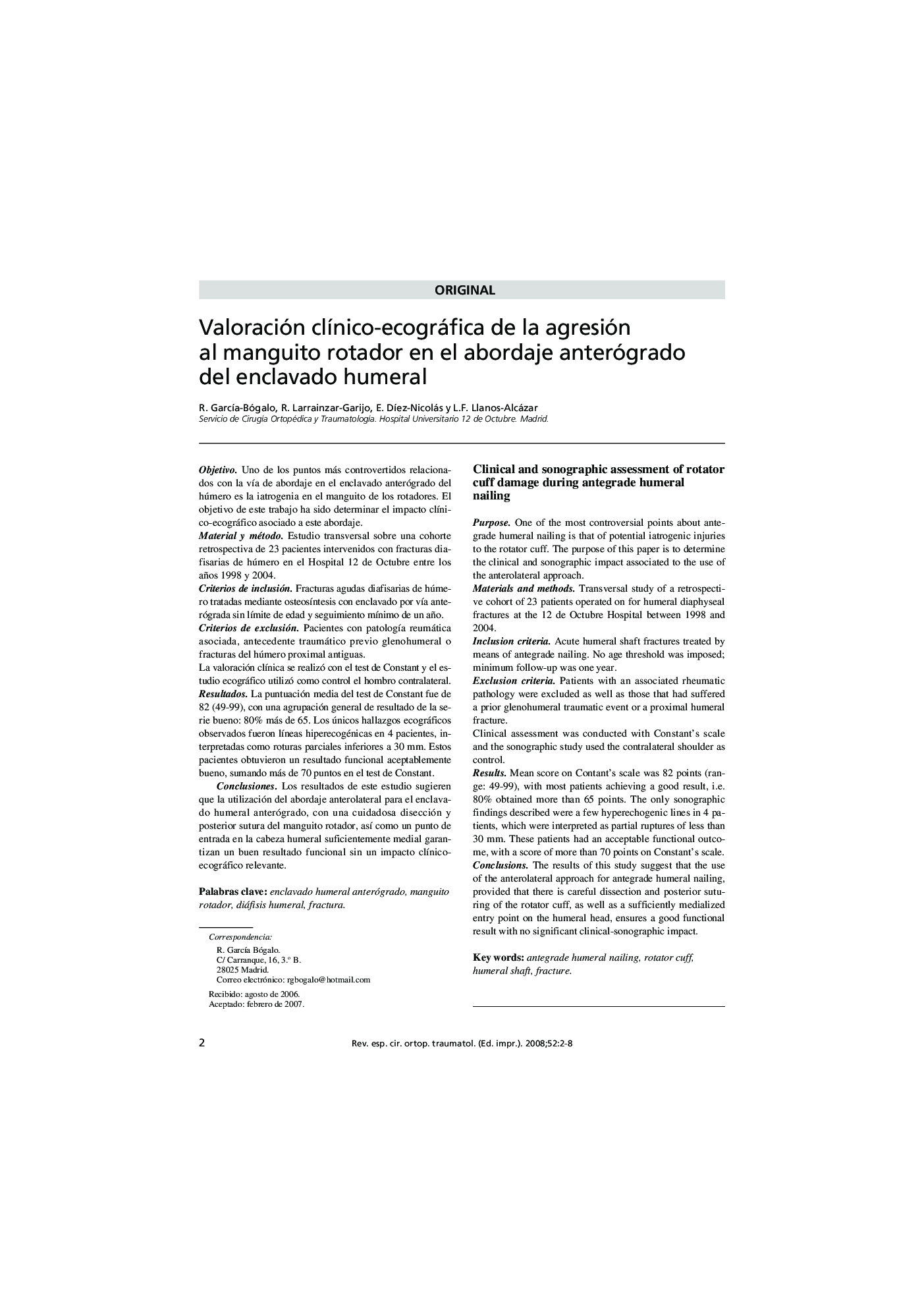| کد مقاله | کد نشریه | سال انتشار | مقاله انگلیسی | نسخه تمام متن |
|---|---|---|---|---|
| 4086770 | 1267974 | 2008 | 7 صفحه PDF | دانلود رایگان |

ObjetivoUno de los puntos más controvertidos relacionados con la vía de abordaje en el enclavado anterógrado del húmero es la iatrogenia en el manguito de los rotadores. El objetivo de este trabajo ha sido determinar el impacto clínico-ecográfico asociado a este abordaje.Material y métodoEstudio transversal sobre una cohorte retrospectiva de 23 pacientes intervenidos con fracturas diafisarias de húmero en el Hospital 12 de Octubre entre los años 1998 y 2004.Criterios de inclusiónFracturas agudas diafisarias de húmero tratadas mediante osteosíntesis con enclavado por vía anterógrada sin límite de edad y seguimiento mínimo de un año.Criterios de exclusiónPacientes con patología reumática asociada, antecedente traumático previo glenohumeral o fracturas del húmero proximal antiguas.La valoración clínica se realizó con el test de Constant y el estudio ecográfico utilizó como control el hombro contralateral.ResultadosLa puntuación media del test de Constant fue de 82 (49-99), con una agrupación general de resultado de la serie bueno: 80% más de 65. Los únicos hallazgos ecográficos observados fueron líneas hiperecogénicas en 4 pacientes, interpretadas como roturas parciales inferiores a 30 mm. Estos pacientes obtuvieron un resultado funcional aceptablemente bueno, sumando más de 70 puntos en el test de Constant.ConclusionesLos resultados de este estudio sugieren que la utilización del abordaje anterolateral para el enclavado humeral anterógrado, con una cuidadosa disección y posterior sutura del manguito rotador, así como un punto de entrada en la cabeza humeral suficientemente medial garantizan un buen resultado funcional sin un impacto clínicoecográfico relevante.
PurposeOne of the most controversial points about antegrade humeral nailing is that of potential iatrogenic injuries to the rotator cuff. The purpose of this paper is to determine the clinical and sonographic impact associated to the use of the anterolateral approach.Materials and methodsTransversal study of a retrospective cohort of 23 patients operated on for humeral diaphyseal fractures at the 12 de Octubre Hospital between 1998 and 2004.Inclusion criteriaAcute humeral shaft fractures treated by means of antegrade nailing. No age threshold was imposed; minimum follow-up was one year.Exclusion criteriaPatients with an associated rheumatic pathology were excluded as well as those that had suffered a prior glenohumeral traumatic event or a proximal humeral fracture.Clinical assessment was conducted with Constant's scale and the sonographic study used the contralateral shoulder as control.ResultsMean score on Contant's scale was 82 points (range: 49-99), with most patients achieving a good result, i.e. 80% obtained more than 65 points. The only sonographic findings described were a few hyperechogenic lines in 4 patients, which were interpreted as partial ruptures of less than 30 mm. These patients had an acceptable functional outcome, with a score of more than 70 points on Constant's scale.ConclusionsThe results of this study suggest that the use of the anterolateral approach for antegrade humeral nailing, provided that there is careful dissection and posterior suturing of the rotator cuff, as well as a sufficiently medialized entry point on the humeral head, ensures a good functional result with no significant clinical-sonographic impact.
Journal: Revista Española de Cirugía Ortopédica y Traumatología - Volume 52, Issue 1, February 2008, Pages 2–8